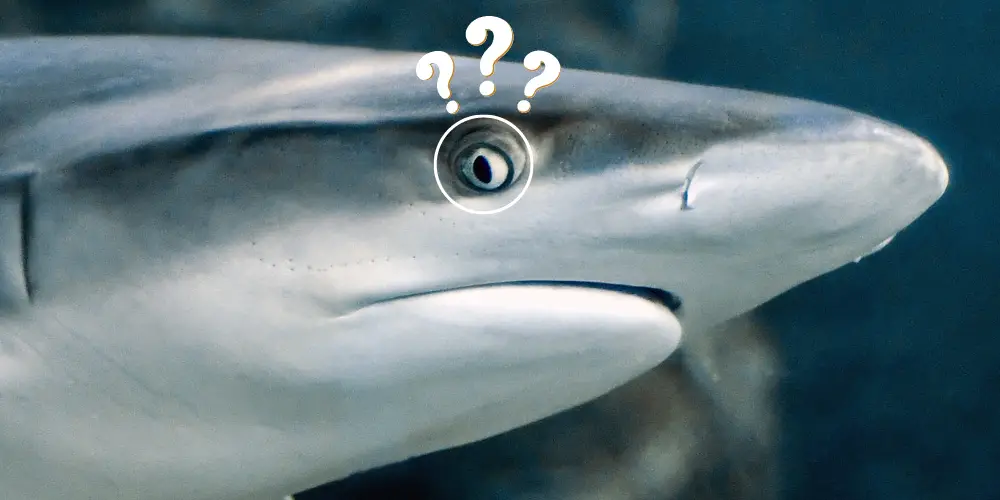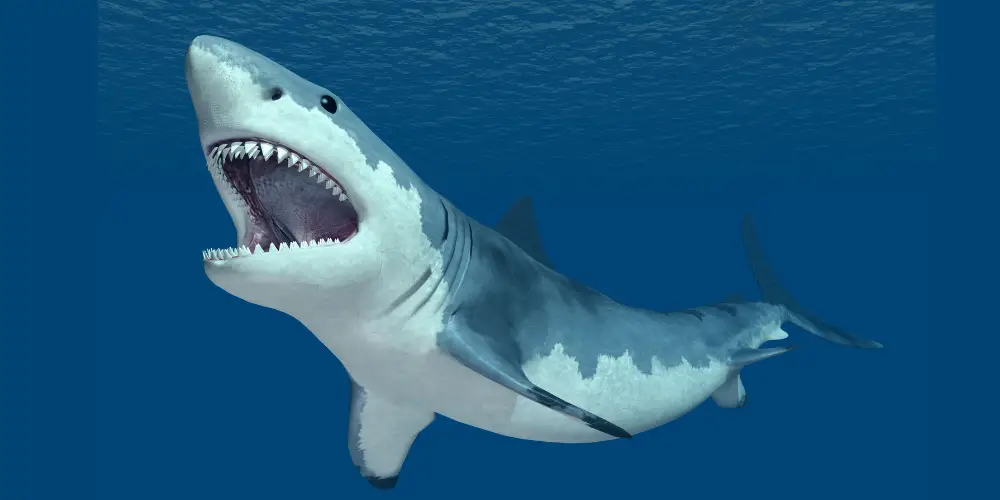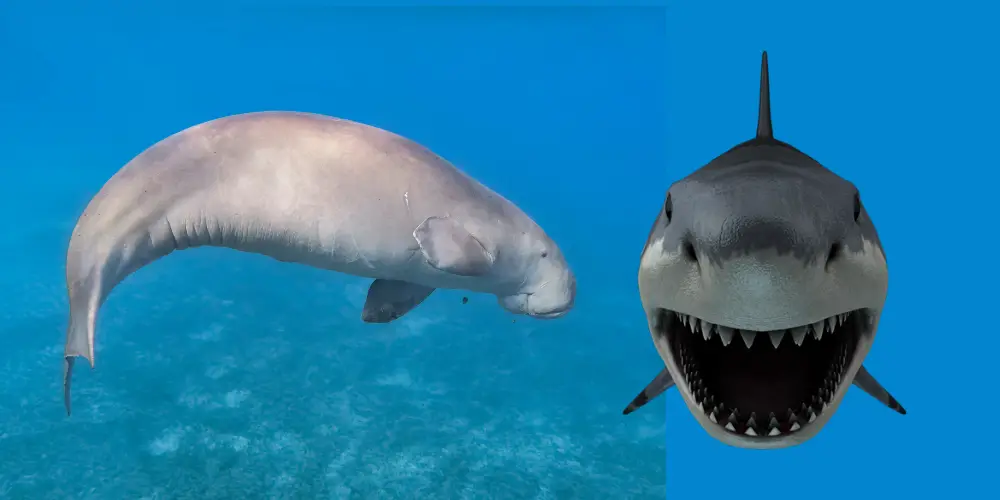Have you ever found yourself captivated by the mysterious world of sharks and wondered about their unique adaptations? One question that often sparks curiosity is, “Do sharks have eyelids?”
Sharks have eyelids, but they function differently from human eyelids. Instead of blinking, sharks use a nictitating membrane, also known as a “third eyelid,” to protect their eyes and maintain vision underwater.
Shark eyelids are a fascinating topic that delves into these incredible ocean predators’ intricate anatomy and survival strategies.
As shark lovers, understanding the features that make these creatures such formidable predators is part of the allure.
Sharks are not just about the sharp teeth and the dorsal fins we often see in movies. They are complex creatures with fascinating adaptations; their eyes are no exception.
So, let’s dive deep and explore the intriguing question: Do sharks have eyelids?
Join us as we unravel the mysteries of shark eyes and their unique adaptations.
Key Takeaways
- Sharks possess eyelids, but they function differently from those of humans, primarily serving as a protective mechanism during feeding or when facing potential threats.
- The structure and function of shark eyelids vary significantly across different species, reflecting their unique adaptations.
- Some sharks have upper and lower eyelids that don’t close completely, while others, like the Tiger Shark, have a nictitating membrane or “third eyelid” that can draw over the eye.
- Great White Sharks protect their eyes by rolling them back into their heads during an attack.
- Common misconceptions about shark eyelids include believing that all sharks have the same type of eyelids or are blind. These misconceptions are not accurate.
- Understanding the unique adaptations of sharks, such as their eyelids, provides a more accurate picture of these remarkable creatures and underscores the importance of their conservation.
The Function of Shark Eyelids
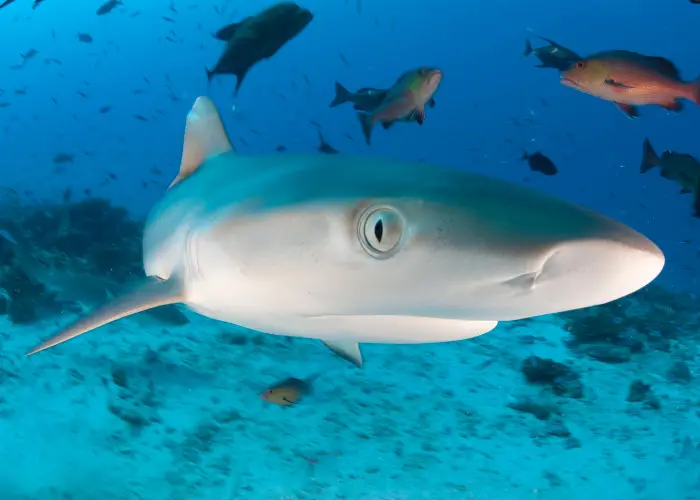
When we think of eyelids, we often associate them with blinking, a mechanism to keep our eyes moist and free from dust.
However, in the case of sharks, their eyelids serve a different, yet equally crucial, function.
Sharks live in a world that is vastly different from ours. The ocean is a dynamic environment filled with potential threats and challenges.
A shark’s eyes are vital for hunting and navigating these waters. Therefore, protecting these essential organs becomes a priority, and this is where the function of shark eyelids comes into play.
Shark eyelids primarily serve as a protective shield. During feeding or when a shark encounters potential threats, the eyelids close to protect the eyes from damage.
This is especially important when sharks hunt or feed on spiny or hard-shelled prey that could injure their eyes.
However, not all sharks protect their eyes in the same way. Some species, such as the Great White Shark, roll their eyes back into their heads for protection during an attack.
Others, like the Tiger Shark, have a nictitating membrane – a translucent lid that draws over the eye for protection.
In essence, the function of shark eyelids goes beyond what we typically associate with eyelids.
They testify to the shark’s adaptation to its marine environment, crucial to its survival and success as an ocean apex predator.
Different Types of Eyelids in Sharks
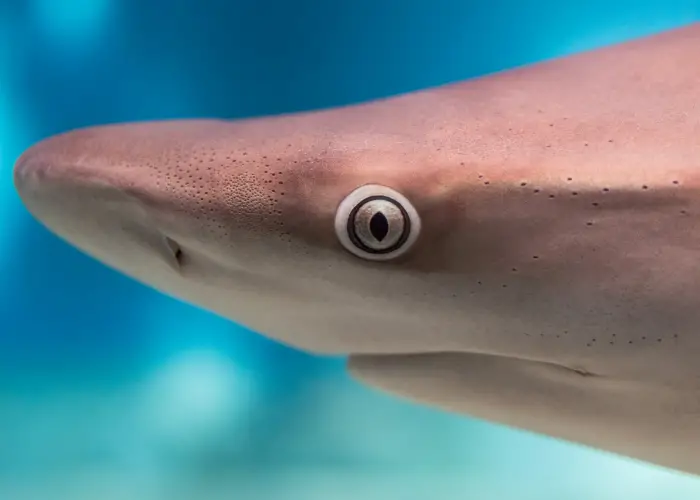
Sharks are diverse creatures, with over 400 species populating our oceans. This diversity extends to their eyelids as well.
While all sharks have some form of an eyelid, the structure and function can vary significantly between species, reflecting their unique adaptations.
1. Upper and Lower Eyelids
Most sharks have what can be considered upper and lower eyelids. However, unlike human eyelids, these do not close completely. They remain open, allowing the shark to see, while the surrounding water keeps their eyes clean and moist.
2. Nictitating Membrane
Some sharks, such as the Tiger Shark and Bull Shark, have a special adaptation called a nictitating membrane.
This is a third eyelid, a translucent cover that can draw over the eye. The nictitating membrane is a protective shield, particularly useful when these sharks are hunting or feeding.
Carcharhinid and sphyrnid sharks, which include species like the great white shark and hammerhead shark, have nictitating membranes or “third eyelids” that cover their eyes completely during their feeding activities. The outer surface of this membrane is covered with dermal denticles, which likely enhances its protective ability.
Tomita, T., Murakumo, K., Miyamoto, K., Sato, K., Oka, S., Kamisako, H., et al. (2016). Eye retraction in the giant guitarfish, Rhynchobatus djiddensis (Elasmobranchii: Batoidea): a novel mechanism for eye protection in batoid fishes. Zoology, 119, 30-35. PMID: 26468088.
It allows them to maintain some vision while protecting their eyes from potential injury from struggling prey or debris.
3. Eye-Rolling
Great White Sharks, one of the most renowned species of sharks, have a different method of eye protection.
Instead of a nictitating membrane, they roll their eyes back into their heads when they attack their prey. This action protects the eyes from damage while the shark is feeding.
4. Eyelid-Less Sharks
Contrary to the norm, some sharks, such as the Hammerhead Sharks, do not have true eyelids. Instead, they have a hard, clear cap over their eyes, providing protection.
The types of eyelids in sharks are as diverse as the species themselves. Each adaptation reflects the unique challenges different species face in their specific habitats and hunting habits.
These variations underscore the incredible adaptability of sharks, enabling them to thrive in a wide range of oceanic environments.
Do Sharks Blink?
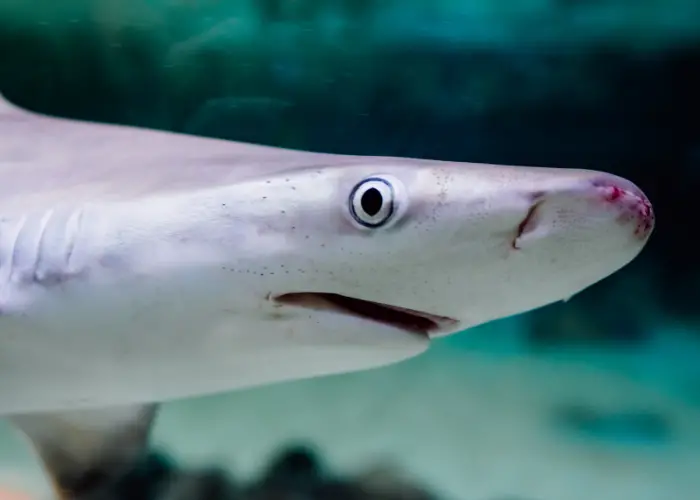 “Do sharks blink?” is a question that often follows the revelation that sharks have eyelids.
“Do sharks blink?” is a question that often follows the revelation that sharks have eyelids.
The answer, however, is not as straightforward as one might expect.
Like humans and many terrestrial animals, sharks do not blink to moisten or clean their eyes. Instead, the ocean water does that job, continuously washing over their eyes to remove any debris.
The primary function of blinking in many animals is to protect and clean the eye. However, blinking as we know it is unnecessary in the underwater world of sharks.
The constant contact with water keeps their eyes clean, and the eyelids or other protective mechanisms come into play when the sharks feed or face potential threats.
Interestingly, the term “blink” may have a different meaning when discussing sharks.
In some species, such as the Great White Shark, you might observe what appears to be a “blink” when they attack their prey.
However, this is not a blink in the traditional sense. Instead, it’s a protective mechanism where the shark rolls its eyes backward into the socket when threatened or closes its eyelids to prevent injury during the attack.
While sharks do not blink to clean or moisten their eyes like humans, they have unique mechanisms to protect their vision.
These adaptations, whether it’s rolling their eyes back or using a nictitating membrane, are part of what makes sharks such fascinating creatures of the deep.
Interesting Facts about Sharks and Their Eyes
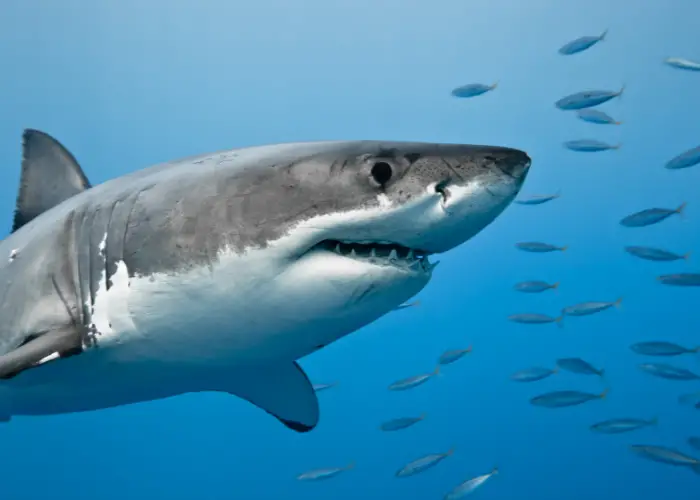
Just when you thought these marine marvels couldn’t get any more fascinating, let’s delve into some amazing “shark facts” that highlight the wonder of these creatures, especially focusing on their eyes.
Fact 1: Sharks have Incredible Night Vision
If you thought cats were the masters of night vision, think again.
Sharks can see in the dark thanks to a special tissue called the tapetum lucidum, located behind the retina.
This layer of cells reflects light through the retina, giving the photoreceptor cells a second chance to pick up any light that initially passed through.
This adaptation increases the sensitivity of “shark eyes” in low light conditions, making them excellent hunters, even in the dead of night.
Fact 2: Some Sharks Can Glow in the Dark
Speaking of the dark, some sharks see well in the dark and emit light! Species such as the Lanternshark have bioluminescent properties.
They possess photophores, special light-emitting organs that help them camouflage against predators and potentially communicate with other sharks.
Fact 3: Sharks Can’t Blink Like Humans
One of the most mind-boggling “shark facts” relates to their inability to blink like humans.
As discussed earlier, some sharks have a nictitating membrane that they can draw over their eyes but can’t blink like humans. This is because their eyelids do not meet in the middle, unlike ours.
Fact 4: Sharks May be Farsighted
While sharks have excellent vision, they are believed to be farsighted, seeing objects in the distance more clearly than those close up.
This is due to the position of the eyes on the sides of their head, which gives them a broad field of vision but less focus on the area right in front of them.
Fact 5: The Eyes of Sharks Are Equipped for Defense
Shark eyes, like many predatory species, are equipped with natural defensive mechanisms.
Depending on the species, the hard, clear eyelids (nictitating membrane) or spiracles act as shields, protecting the eyes during predatory or defensive encounters.
There you have it, some awe-inspiring “shark facts” focusing on their intriguing “shark eyes.”
These facts not only underline the complex adaptations of sharks but also serve as a reminder of how every facet of these incredible creatures is designed for survival and efficiency in the vast and often unforgiving ocean.
Conclusion
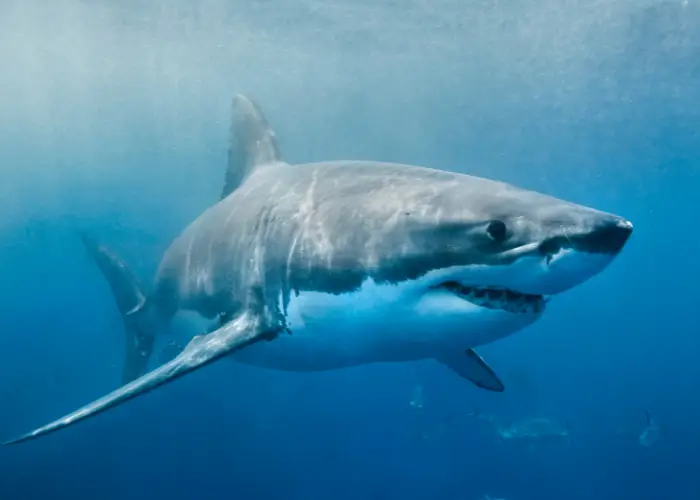
Exploring the question, “Do sharks have eyelids?” we have journeyed into the fascinating world of shark anatomy and adaptations.
We’ve learned that sharks have eyelids, and these structures play a crucial role in their survival, offering protection during feeding and potential threats.
We’ve discovered that the function of shark eyelids extends beyond the familiar act of blinking.
Instead, they serve as a protective shield, with the ocean water keeping their eyes clean.
We’ve also seen the diversity in eyelid types across different shark species, from the nictitating membrane of the Tiger Shark to the eye-rolling mechanism of the Great White Shark.
In debunking common misconceptions, we’ve clarified that sharks are not blind and that their eyelids serve a purpose quite different from those of humans.
This exploration underscores the importance of understanding these magnificent creatures beyond the myths and fears that often surround them.
As we conclude this deep dive into the world of shark eyelids, we hope that you’ve gained a deeper appreciation for these incredible marine predators.
Their unique adaptations, such as their eyelids, show the intricate balance of life in the ocean.
Understanding sharks and their anatomy is not just about satisfying our curiosity.
It’s also about fostering respect and conservation efforts for these vital apex predators, ensuring the health and diversity of our oceans for generations to come.
EXPLORE MORE WEIRD TOPICS ABOUT SHARKS:
- Do Sharks Yawn?
- Do Sharks Feel Pain? [ Diving into the Depths of Sensation ]
- Do Sharks Have Tongues?
- Do Rainbow Sharks Get Along with Bettas? ( The Aquarium Debate )
REFERENCES:
1. Shark. (2023, May 18). In Wikipedia. https://en.wikipedia.org/wiki/Shark
2. Tomita, T., Murakumo, K., Komoto, S., Dove, A., Kino, M., Miyamoto, K., & Toda, M. (2020). Armored eyes of the whale shark. PLOS ONE, 15(6), e0235342. https://doi.org/10.1371/journal.pone.0235342

